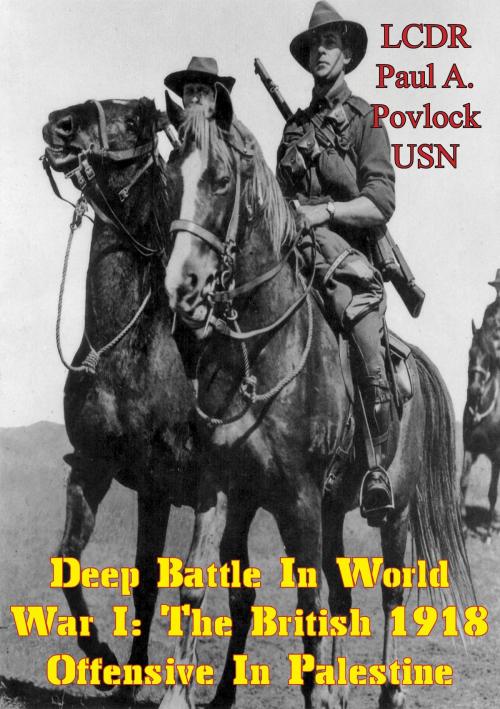Deep Battle In World War I: The British 1918 Offensive In Palestine
Nonfiction, History, Military, World War I, Germany, British| Author: | LCDR Paul A. Povlock USN | ISBN: | 9781786250230 |
| Publisher: | Verdun Press | Publication: | November 6, 2015 |
| Imprint: | Verdun Press | Language: | English |
| Author: | LCDR Paul A. Povlock USN |
| ISBN: | 9781786250230 |
| Publisher: | Verdun Press |
| Publication: | November 6, 2015 |
| Imprint: | Verdun Press |
| Language: | English |
Maneuver Warfare Theory achieved major acceptance during the 1980’s, emphasizing the conduct of simultaneous offensive operations throughout the depth of the battlefield. With the victory of Coalition forces during Operation DESERT STORM, the “deep battle” theory gained instant credibility and the emphasis on “joint” operations reached a fever pitch. Yet, too often analysts have only used the war in Kuwait to prove or refute these operational concepts. All theories require more than one case study to validate or nullify their precepts. Other historical examples need to be examined using the model of maneuver warfare to give greater support for this theory.
While the First World War is often characterized by the futile attrition of the Western Front in France, many exceptional operational offensives were also conducted. The British September 1918 offensive in Palestine is a superb example of the proper application of combat forces at the operational level. General Edmund Allenby’s use of regular army units, armored cars, cavalry, airpower and irregulars led to a major victory that hastened the collapse of Turkey and the Central Powers. Long before mechanized forces and maneuver theory had been developed, British Imperial forces executed an operational design stressing many elements of deep battle theory.
By examining the British offensive using the paradigm of maneuver warfare, additional evidence can be generated to add credence to the theory. The importance of the synergistic effect of combat arms when applied jointly is also shown. Maneuver theory must be better understood if this paradigm is used to create doctrine for the employment of the Armed Forces of the United States.
Maneuver Warfare Theory achieved major acceptance during the 1980’s, emphasizing the conduct of simultaneous offensive operations throughout the depth of the battlefield. With the victory of Coalition forces during Operation DESERT STORM, the “deep battle” theory gained instant credibility and the emphasis on “joint” operations reached a fever pitch. Yet, too often analysts have only used the war in Kuwait to prove or refute these operational concepts. All theories require more than one case study to validate or nullify their precepts. Other historical examples need to be examined using the model of maneuver warfare to give greater support for this theory.
While the First World War is often characterized by the futile attrition of the Western Front in France, many exceptional operational offensives were also conducted. The British September 1918 offensive in Palestine is a superb example of the proper application of combat forces at the operational level. General Edmund Allenby’s use of regular army units, armored cars, cavalry, airpower and irregulars led to a major victory that hastened the collapse of Turkey and the Central Powers. Long before mechanized forces and maneuver theory had been developed, British Imperial forces executed an operational design stressing many elements of deep battle theory.
By examining the British offensive using the paradigm of maneuver warfare, additional evidence can be generated to add credence to the theory. The importance of the synergistic effect of combat arms when applied jointly is also shown. Maneuver theory must be better understood if this paradigm is used to create doctrine for the employment of the Armed Forces of the United States.

![Cover of the book The Coldstream Guards, 1914-1918 Vol. I [Illustrated Edition] by LCDR Paul A. Povlock USN](https://www.kuoky.com/images/2015/november/300x300/9781786250995-9rTG_300x.jpg)


![Cover of the book Marines In World War II - The Seizure Of Tinian [Illustrated Edition] by LCDR Paul A. Povlock USN](https://www.kuoky.com/images/2014/august/300x300/9781782892885-afGw_300x.jpg)



![Cover of the book The First Seven Divisions, Being A Detailed Account Of The Fighting From Mons To Ypres. [Illustrated Edition] by LCDR Paul A. Povlock USN](https://www.kuoky.com/images/2012/april/300x300/9781782890843-FQ7G_300x.jpg)
![Cover of the book Of Rice And Men [Illustrated Edition] by LCDR Paul A. Povlock USN](https://www.kuoky.com/images/2015/november/300x300/9781786253255-tQ9N_300x.jpg)

![Cover of the book Merrill’s Marauders February - May 1944 [Illustrated Edition] by LCDR Paul A. Povlock USN](https://www.kuoky.com/images/2014/august/300x300/9781782894506-MdWV_300x.jpg)



